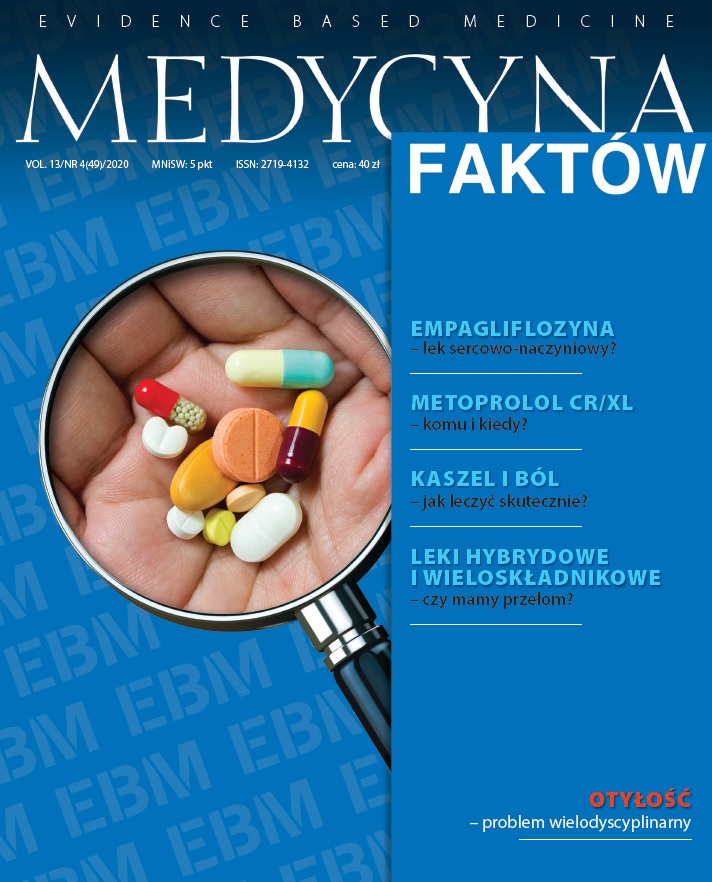Rola farmaceuty w leczeniu astmy – nie tylko lek ma znaczenie Artykuł przeglądowy
##plugins.themes.bootstrap3.article.main##
Abstrakt
Odpowiedni dobór i prawidłowe stosowanie inhalatorów są integralną częścią postępowania w przypadku astmy i przewlekłej obturacyjnej choroby płuc. Powszechnie wiadomo, że jest wiele wyzwań związanych z używaniem inhalatorów, a żadne urządzenie nie jest odpowiednie dla wszystkich pacjentów. Co ważne, edukacja i wsparcie są potrzebne, nie tylko po to, aby umożliwić pacjentom rozpoznanie potrzeby optymalnego leczenia choroby, lecz także aby pomóc im opracować dobrą technikę inhalacji. Ponadto pracownicy służby zdrowia powinni również dążyć do poszerzenia swojej wiedzy na temat przepisywanych wyrobów i opracować systemy zapewniające kompleksowe wsparcie pacjentom w praktyce klinicznej.
##plugins.themes.bootstrap3.article.details##
Jak cytować
Postuła , M. (2020). Rola farmaceuty w leczeniu astmy – nie tylko lek ma znaczenie. Medycyna Faktów , 13(4(49), 442-444. https://doi.org/10.24292/01.MF.0420.8
Numer
Dział
Artykuły
Copyright © by Medical Education. All rights reserved.
Bibliografia
1. Bonini M, Usmani OS. The importance of inhaler devices in the treatment of COPD. COPD Res Pract. 2015; 1(1): 9.
2. Lavorini F, Corrigan CJ, Barnes PJ et al. Aerosol Drug Management Improvement Team. Retail sales of inhalation devices in European countries: so much for a global policy. Respir Med. 2011; 105(7): 1099-103.
3. Ari A, Fink JB. Guidelines for aerosol devices in infants, children and adults: which to choose, why and how to achieve effective aerosol therapy. Expert Rev Respir Med. 2011; 5(4): 561-72.
4. Westerik JA, Carter V, Chrystyn H et al. Characteristics of patients making serious inhaler errors with a dry powder inhaler and association with asthma-related events in a primary care setting. J Asthma. 2016; 53(3): 321-9.
5. Levy ML, Hardwell A, McKnight E et al. Asthma patients’ inability to use a pressurised metered-dose inhaler (pMDI) correctly correlates with poor asthma control as defined by the global initiative for asthma (GINA) strategy: a retrospective analysis. Prim Care Respir J. 2013; 22(4): 406-11.
6. Hodder R, Price D. Patient preferences for inhaler devices in chronic obstructive pulmonary disease: experience with Respimat Soft Mist inhaler. Int J Chron Obstruct Pulmon Dis. 2009; 4: 381-90.
7. Bonini M, Usmani OS. The importance of inhaler devices in the treatment of COPD. COPD Res Pract. 2015; 1(1): 9.
8. Inhaler Error Steering Committee, Price D, Bosnic-Anticevich S et al. Inhaler competence in asthma: common errors, barriers to use and recommended solutions. Respir Med. 2013; 107(1): 37-46.
9. Lavorini F, Usmani OS. Correct inhalation technique is critical in achieving good asthma control. Prim Care Respir J. 2013; 22(4): 385-6.
10. Small M, Anderson P, Vickers A et al. Importance of inhaler-device satisfaction in asthma treatment: real-world observations of physician-observed compliance and clinical/patient-reported outcomes. Adv Ther. 2011; 28(3): 202-12.
11. Lavorini F, Levy ML, Corrigan C et al; ADMIT Working Group. The ADMIT series – issues in inhalation therapy. 6) Training tools for inhalation devices. Prim Care Respir J. 2010; 19(4): 335-41.
12. Normansell R, Kew KM, Mathioudakis AG. Interventions to improve inhaler technique for people with asthma. Cochrane Database Syst Rev. 2017; 3: CD012286.
13. Bosnic-Anticevich SZ, Sinha H, So S et al. Metered-dose inhaler technique: the effect of two educational interventions delivered in community pharmacy over time. J Asthma. 2010; 47(3): 251-6.
14. Goodwin R, Heraghty J. Do healthcare professionals understand asthma devices? Arch Dis Child Educ Pract Ed. 2015; 100(6): 302-5.
2. Lavorini F, Corrigan CJ, Barnes PJ et al. Aerosol Drug Management Improvement Team. Retail sales of inhalation devices in European countries: so much for a global policy. Respir Med. 2011; 105(7): 1099-103.
3. Ari A, Fink JB. Guidelines for aerosol devices in infants, children and adults: which to choose, why and how to achieve effective aerosol therapy. Expert Rev Respir Med. 2011; 5(4): 561-72.
4. Westerik JA, Carter V, Chrystyn H et al. Characteristics of patients making serious inhaler errors with a dry powder inhaler and association with asthma-related events in a primary care setting. J Asthma. 2016; 53(3): 321-9.
5. Levy ML, Hardwell A, McKnight E et al. Asthma patients’ inability to use a pressurised metered-dose inhaler (pMDI) correctly correlates with poor asthma control as defined by the global initiative for asthma (GINA) strategy: a retrospective analysis. Prim Care Respir J. 2013; 22(4): 406-11.
6. Hodder R, Price D. Patient preferences for inhaler devices in chronic obstructive pulmonary disease: experience with Respimat Soft Mist inhaler. Int J Chron Obstruct Pulmon Dis. 2009; 4: 381-90.
7. Bonini M, Usmani OS. The importance of inhaler devices in the treatment of COPD. COPD Res Pract. 2015; 1(1): 9.
8. Inhaler Error Steering Committee, Price D, Bosnic-Anticevich S et al. Inhaler competence in asthma: common errors, barriers to use and recommended solutions. Respir Med. 2013; 107(1): 37-46.
9. Lavorini F, Usmani OS. Correct inhalation technique is critical in achieving good asthma control. Prim Care Respir J. 2013; 22(4): 385-6.
10. Small M, Anderson P, Vickers A et al. Importance of inhaler-device satisfaction in asthma treatment: real-world observations of physician-observed compliance and clinical/patient-reported outcomes. Adv Ther. 2011; 28(3): 202-12.
11. Lavorini F, Levy ML, Corrigan C et al; ADMIT Working Group. The ADMIT series – issues in inhalation therapy. 6) Training tools for inhalation devices. Prim Care Respir J. 2010; 19(4): 335-41.
12. Normansell R, Kew KM, Mathioudakis AG. Interventions to improve inhaler technique for people with asthma. Cochrane Database Syst Rev. 2017; 3: CD012286.
13. Bosnic-Anticevich SZ, Sinha H, So S et al. Metered-dose inhaler technique: the effect of two educational interventions delivered in community pharmacy over time. J Asthma. 2010; 47(3): 251-6.
14. Goodwin R, Heraghty J. Do healthcare professionals understand asthma devices? Arch Dis Child Educ Pract Ed. 2015; 100(6): 302-5.
